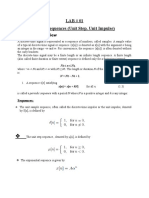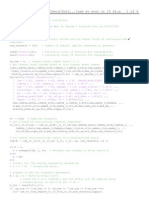0 ratings0% found this document useful (0 votes)
17 viewsDiscrete Diff Int PDF
The document defines impulse and step signals with and without delays. It then computes the difference between the original and delayed signals. It applies discrete differentiation and integration to the difference signals and plots the original, derivative, and integral signals. The purpose is to examine how discrete differentiation and integration operators work on signals with delays.
Uploaded by
Song Hang ChaiCopyright
© © All Rights Reserved
Available Formats
Download as PDF, TXT or read online on Scribd
0 ratings0% found this document useful (0 votes)
17 viewsDiscrete Diff Int PDF
The document defines impulse and step signals with and without delays. It then computes the difference between the original and delayed signals. It applies discrete differentiation and integration to the difference signals and plots the original, derivative, and integral signals. The purpose is to examine how discrete differentiation and integration operators work on signals with delays.
Uploaded by
Song Hang ChaiCopyright
© © All Rights Reserved
Available Formats
Download as PDF, TXT or read online on Scribd
You are on page 1/ 2
25/2/23 3:04 PM test.
m 1 of 2
% Define the range of values for n
n = -10:20;
% Define the impulse signal
impulse_n = [zeros(1,10) 1 zeros(1,10)];
% Define the impulse signal with delay of 5
impulse_n5 = [zeros(1,15) 1 zeros(1,5)];
% Compute the difference signal
diff_impulse_n = impulse_n - impulse_n5;
% Define the step signal using u(n)
u = (n >= 0);
step_n = u;
% Define the step signal with delay of 11 using u(n-11)
u11 = (n-11 >= 0);
step_n11 = u11;
% Compute the difference signal
diff_step_n = step_n - step_n11;
% Apply discrete differentiator and integrator
Ts = 0.01; % Sampling time interval
diff_diff_impulse_n = discrete_differentiator(diff_impulse_n, Ts);
diff_diff_step_n = discrete_differentiator(diff_step_n, Ts);
int_diff_impulse_n = discrete_integrator(diff_impulse_n, Ts);
int_diff_step_n = discrete_integrator(diff_step_n, Ts);
% Plot the signals and their derivatives/integrals
% The y variables of stem(x,y) in these cases are one element less than x
% variable, thus I adjust the length of n accordingly
figure(1);
subplot(3,1,1);
stem(n(1:length(diff_impulse_n)), diff_impulse_n);
title('Impulse Function[n] - Impulse Function[n-5]', 'FontSize', 16);
xlabel('n', 'FontSize', 14);
ylabel('Amplitude', 'FontSize', 14);
% Derivatives of impulse function
subplot(3,1,2);
stem(n(1:length(diff_diff_impulse_n)), diff_diff_impulse_n);
title('Derivative of Impulse Function[n] - Impulse Function[n-5]', 'FontSize', 16);
xlabel('n', 'FontSize', 14);
ylabel('Amplitude', 'FontSize', 14);
% Integrals of impulse function
subplot(3,1,3);
stem(n(1:length(int_diff_impulse_n)), int_diff_impulse_n);
title('Integral of Impulse Function[n] - Impulse Function[n-5]', 'FontSize', 16);
xlabel('n', 'FontSize', 14);
ylabel('Amplitude', 'FontSize', 14);
% Plot the signals and their derivatives/integrals
% The y variables of stem(x,y) in these cases are one element less than x
% variable, thus I adjust the length of n accordingly
figure(2);
subplot(3,1,1);
stem(n(1:length(diff_step_n)), diff_step_n);
title('Step Function[n] - Step Function[n-11]', 'FontSize', 16);
xlabel('n', 'FontSize', 14);
25/2/23 3:04 PM test.m 2 of 2
ylabel('Amplitude', 'FontSize', 14);
% Derivatives of step function
subplot(3,1,2);
stem(n(1:length(diff_diff_step_n)), diff_diff_step_n);
title('Derivative of Step Function[n] - Step Function[n-11]', 'FontSize', 16);
xlabel('n', 'FontSize', 14);
ylabel('Amplitude', 'FontSize', 14);
% Integrals of step function
subplot(3,1,3);
stem(n(1:length(int_diff_step_n)), int_diff_step_n);
title('Integral of Step Function[n] - Step Function[n-11]', 'FontSize', 16);
xlabel('n', 'FontSize', 14);
ylabel('Amplitude', 'FontSize', 14);
You might also like
- Find The Impulse Response of A Discrete Time System Whose Function Is Given AsNo ratings yetFind The Impulse Response of A Discrete Time System Whose Function Is Given As5 pages
- TE (ICE) Signals and Systems Lab ManualNo ratings yetTE (ICE) Signals and Systems Lab Manual16 pages
- EE Specialization Area Lab - Wireless Module: RangingNo ratings yetEE Specialization Area Lab - Wireless Module: Ranging10 pages
- To Perform Linear Convolution Upon Two Given Discrete Time SignalsNo ratings yetTo Perform Linear Convolution Upon Two Given Discrete Time Signals1 page
- Experiment No. - 1: Aim: Software Used: MATLAB TheoryNo ratings yetExperiment No. - 1: Aim: Software Used: MATLAB Theory18 pages
- LAB # 01 Digital Sequences (Unit Step, Unit Impulse) : Background ReviewNo ratings yetLAB # 01 Digital Sequences (Unit Step, Unit Impulse) : Background Review6 pages
- Digital Signal Processing Matlab ProgramNo ratings yetDigital Signal Processing Matlab Program5 pages
- %初始化 %¸个体经验保留 %全局经验保留 %×最大迭代次数 %%微粒数 %问题的规模(城市规模) %迭代计数器 %¸各代最佳路线 % 各代最佳路线的长度 %¸各代路线的平均长度 %产生微粒数的初始位置 for i=1:mNo ratings yet%初始化 %¸个体经验保留 %全局经验保留 %×最大迭代次数 %%微粒数 %问题的规模(城市规模) %迭代计数器 %¸各代最佳路线 % 各代最佳路线的长度 %¸各代路线的平均长度 %产生微粒数的初始位置 for i=1:m3 pages
- 11.instructional Manual Sample Program OutputNo ratings yet11.instructional Manual Sample Program Output30 pages
- 1/22/13 11:58 AM C:/Users/Solo... /uwb - SV - Eval - CT - 15 - 4a.m 1 of 4No ratings yet1/22/13 11:58 AM C:/Users/Solo... /uwb - SV - Eval - CT - 15 - 4a.m 1 of 44 pages
- %simulation Length %channel Length %number of Independent TrialsNo ratings yet%simulation Length %channel Length %number of Independent Trials2 pages
- Experiment No. 2 AIM:-Write A MATLAB Program To Generate Standard Discrete Time Signals andNo ratings yetExperiment No. 2 AIM:-Write A MATLAB Program To Generate Standard Discrete Time Signals and9 pages
- Plotting Common Discrete Time Signals, & Downsample and Upsample of SignalNo ratings yetPlotting Common Discrete Time Signals, & Downsample and Upsample of Signal2 pages
- School of Risk and Actuarial Studies - UG - StudentNo ratings yetSchool of Risk and Actuarial Studies - UG - Student1 page
- IB-2018 - Use of Calculators in Examinations PDFNo ratings yetIB-2018 - Use of Calculators in Examinations PDF9 pages
- Netsolving Problems Involving Conversion of Units of MeasurementNo ratings yetNetsolving Problems Involving Conversion of Units of Measurement28 pages
- P - 5 Primary Five Mathematics Notes Term 1 3No ratings yetP - 5 Primary Five Mathematics Notes Term 1 399 pages
- P43 2014-01-31 Pixar - The Math Behind The Movies - Tony DeRoseNo ratings yetP43 2014-01-31 Pixar - The Math Behind The Movies - Tony DeRose2 pages
- Numerical Modeling and Mechanical Analysis of Flexible RisersNo ratings yetNumerical Modeling and Mechanical Analysis of Flexible Risers8 pages
- In A Suspension: Physica North-Holland Publishing CoNo ratings yetIn A Suspension: Physica North-Holland Publishing Co37 pages
- 2024 Mathematics Olympiad Past Paper Central Province Category III English MediumNo ratings yet2024 Mathematics Olympiad Past Paper Central Province Category III English Medium5 pages























































































